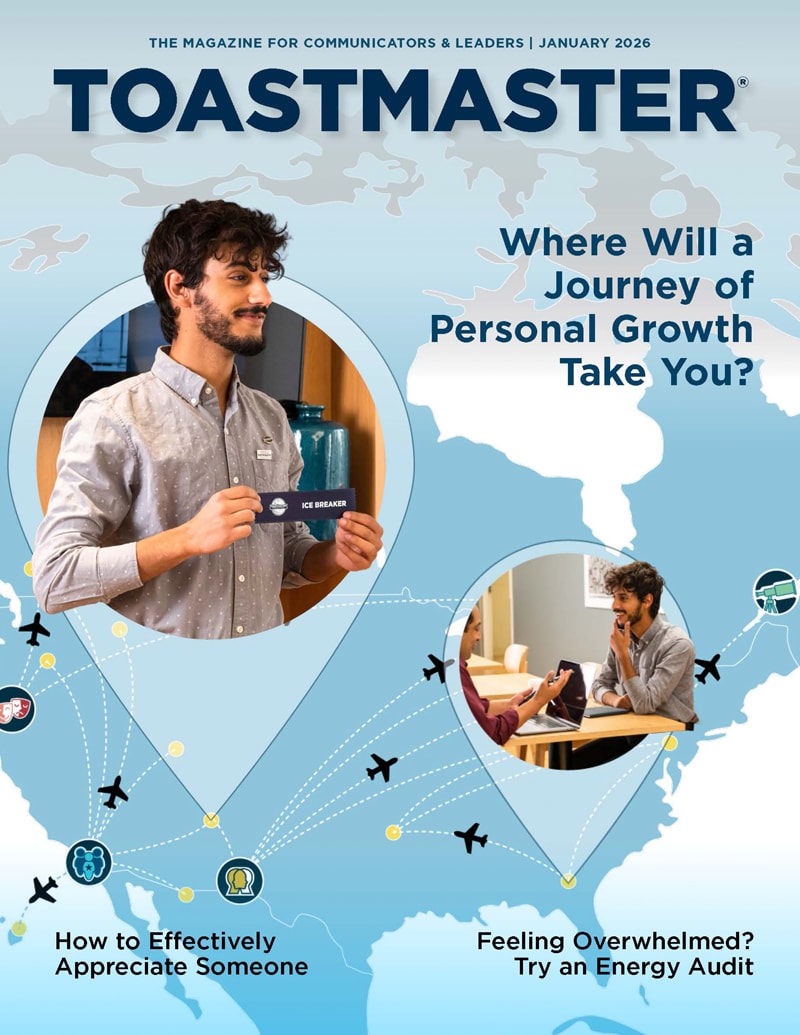
July marks a fresh chapter in every Toastmasters year. Clubs welcome new officers and Districts install new leaders. It’s a time brimming with optimism and opportunity—a perfect moment to reflect not just on goals and growth, but on the kind of environment being created for members.
Toastmasters talk a lot about leadership, communication, and club excellence—but at the heart of every thriving member’s experience is a sense of belonging. When members feel seen, valued, and included, they stay engaged. They speak up. They grow. So, how can leaders and members ensure that their clubs don’t just run smoothly, but also feel welcoming and inclusive to everyone?
Here are five practical ways for club leaders to foster belonging and inclusion in Toastmasters clubs throughout the year.
- Be intentional with member check-ins.
It’s easy to assume everyone is doing fine, but assumptions don’t build connection. Regular, intentional check-ins are a powerful way to show members they matter.
- Early in the year (July–August): Reach out to each member and schedule a short one-on-one conversation. Ask about their goals, challenges, and what they’d like from the club this year. This not only sets a welcoming tone but can also uncover hidden needs or talents.
- Mid-year (January): Plan a mid-year pulse check. It could be a survey or informal chats. Ask “How are we doing as a club?” and “What can we do to help you feel more connected?”
- Celebrate what makes each member unique.
Diversity and inclusion aren’t just about background or demographics. They’re also about personality, communication style, and life experience. One of the simplest ways to foster inclusion is to celebrate that uniqueness.
- At the first few meetings of the year: Have a “Get to Know You” segment where members share fun facts, cultural traditions, or something they’re proud of. Even long-time members can reveal something new.
- Throughout the year: Use Table Topics® to invite personal stories. Feature different members in newsletters or social media posts. Assign mentorship pairings that cross generational, cultural, or language lines.
- At every meeting: Kick things off with an icebreaker activity using conversation starter cards, which typically contain question prompts designed to spark meaningful conversations. Each question should promote inclusivity, curiosity, and connection, helping members discover common ground and celebrate differences.
- Acknowledge diverse perspectives before conflict arises.
When we proactively recognize the value of different viewpoints, we build resilience against misunderstandings and tension.
- Start of the year: Encourage your club Executive Committee to discuss and define shared values that honor diverse voices. For example, create space for those who process ideas more slowly or who come from cultures where public disagreement is uncomfortable.
- Before difficult decisions: Whether it’s changing the meeting format or planning a special event, ask “Whose voices haven’t we heard yet?” and “What perspectives might we be overlooking?”
- Cultivate psychological safety in meetings.
Psychological safety—the belief that it’s okay to speak up without fear of embarrassment or rejection—is essential in creating a welcoming environment.
- At every meeting: Start with a warm, inclusive tone. For instance, have the Toastmaster acknowledge that “every speaker brings something valuable, whether they’re on their first speech or their 50th.”
- During evaluations: Train members to give feedback that’s kind, specific, and focused on growth. You might even revisit the club’s approach to evaluations during officer training or a special club workshop.
- Make inclusion a visible, ongoing priority.
Belonging isn’t a one-time event; it’s a continuous commitment. Toastmasters clubs are uniquely suited to model this through leadership and communication.
- Quarterly: Schedule “Inclusion Spotlights” in club or District newsletters. Highlight practices or stories that reflect inclusive behavior.
- Throughout the year: Officers can model inclusive language and behavior. This includes introducing pronouns, inviting diverse speakers, and rotating leadership opportunities.
- During contests and events: Consider logistics (location, accessibility, scheduling, language, etc.) to avoid unintentionally excluding some members. Even small choices can have big ripple effects.
Check-ins aren’t just for troubleshooting. They’re for building trust before issues arise.
The more we understand one another, the more we respect and connect.
By validating diverse perspectives up front, you reduce the chances of members feeling unheard or marginalized later.
When people feel safe to share and stumble, they grow and they stay involved.
Belonging and inclusion don’t just happen—they’re built through small, consistent actions by people who care. As Toastmasters, we already have the tools: intentional leadership, thoughtful communication, and a genuine interest in helping people grow.
As you step into this new program year, ask yourself, What kind of experience do I want members to have? Then lead with that intention. A club where everyone feels they belong is a club where everyone thrives.
Kristin Arnold is a professional meeting facilitator who challenges leaders and their teams to achieve extraordinary results—especially when the stakes are high. Find out more at extraordinaryteam.com.
Related Articles

Diversity and Inclusion
The Habits of Inclusive Communicators

Leadership
Cultivate a Culture of Belonging

Diversity and Inclusion



 Previous
Previous

 Spotlights on Inclusion
Spotlights on Inclusion
 Previous Article
Previous Article